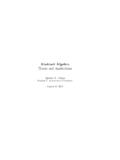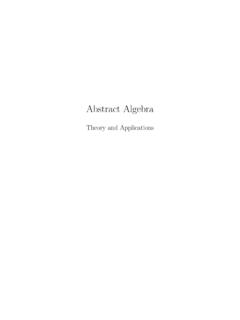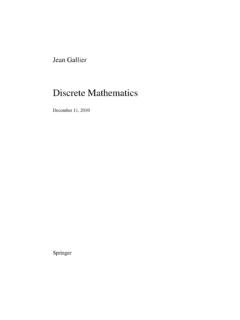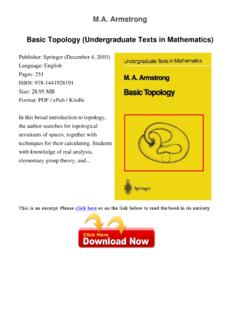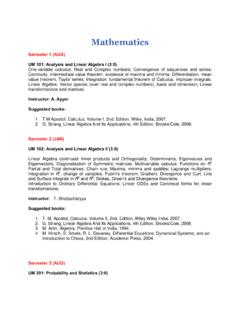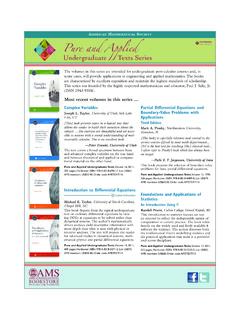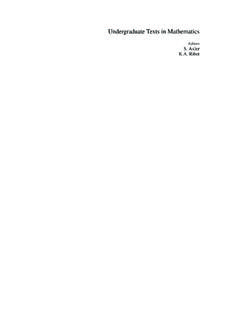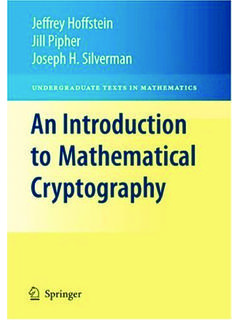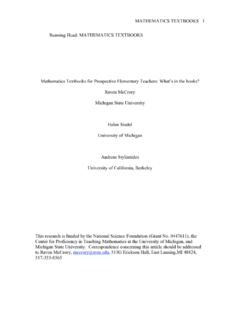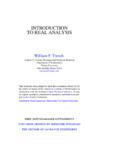Transcription of Abstract Algebra Theory and Applications
1 Abstract AlgebraTheory and ApplicationsThomas W. JudsonStephen F. Austin State UniversityAugust 11, 2012iiCopyright 1997 by Thomas W. is granted to copy, distribute and/or modify this document underthe terms of the GNU Free Documentation License, Version or any laterversion published by the Free Software Foundation; with no Invariant Sections,no Front-Cover texts , and no Back-Cover texts . A copy of the license isincluded in the appendix entitled GNU Free Documentation License .A current version can always be found text is intended for a one- or two-semester undergraduate course inabstract Algebra . Traditionally, these courses have covered the theoreticalaspects of groups, rings, and fields. However, with the development ofcomputing in the last several decades, Applications that involve abstractalgebra and discrete mathematics have become increasingly important, andmany science, engineering, and computer science students are now electingto minor in mathematics .
2 Though Theory still occupies a central role in thesubject of Abstract Algebra and no student should go through such a coursewithout a good notion of what a proof is, the importance of applicationssuch as coding Theory and cryptography has grown recently most Abstract Algebra texts included few if any , one of the major problems in teaching an Abstract Algebra courseis that for many students it is their first encounter with an environment thatrequires them to do rigorous proofs. Such students often find it hard to seethe use of learning to prove theorems and propositions; applied exampleshelp the instructor provide text contains more material than can possibly be covered in a singlesemester. Certainly there is adequate material for a two-semester course, andperhaps more; however, for a one-semester course it would be quite easy toomit selected chapters and still have a useful text.
3 The order of presentationof topics is standard: groups, then rings, and finally fields. Emphasis can beplaced either on Theory or on Applications . A typical one-semester coursemight cover groups and rings while briefly touching on field Theory , usingChapters 1 through 6, 9, 10, 11, 13 (the first part), 16, 17, 18 (the firstpart), 20, and 21. Parts of these chapters could be deleted and applicationssubstituted according to the interests of the students and the instructor. Atwo-semester course emphasizing Theory might cover Chapters 1 through 6,9, 10, 11, 13 through 18, 20, 21, 22 (the first part), and 23. On the otheriiiivPREFACE hand, if Applications are to be emphasized, the course might cover Chapters1 through 14, and 16 through 22. In an applied course, some of the moretheoretical results could be assumed or omitted. A chapter dependency chartappears below.
4 (A broken line indicates a partial dependency.)Chapter 23 Chapter 22 Chapter 21 Chapter 18 Chapter 20 Chapter 19 Chapter 17 Chapter 15 Chapter 13 Chapter 16 Chapter 12 Chapter 14 Chapter 11 Chapter 10 Chapter 8 Chapter 9 Chapter 7 Chapters 1 6 Though there are no specific prerequisites for a course in Abstract Algebra ,students who have had other higher-level courses in mathematics will generallybe more prepared than those who have not, because they will possess a bitmore mathematical sophistication. Occasionally, we shall assume some basiclinear Algebra ; that is, we shall take for granted an elementary knowledgeof matrices and determinants. This should present no great problem, sincemost students taking a course in Abstract Algebra have been introduced tomatrices and determinants elsewhere in their career, if they have not alreadytaken a sophomore- or junior-level course in linear sections are the heart of any mathematics text.
5 An exercise setappears at the end of each chapter. The nature of the exercises ranges overseveral categories; computational, conceptual, and theoretical problems areincluded. A section presenting hints and solutions to many of the exercisesappears at the end of the text. Often in the solutions a proof is only sketched,and it is up to the student to provide the details. The exercises range indifficulty from very easy to very challenging. Many of the more substantialproblems require careful thought, so the student should not be discouragedif the solution is not forthcoming after a few minutes of are additional exercises or computer projects at the ends of manyof the chapters. The computer projects usually require a knowledge ofprogramming. All of these exercises and projects are more substantial innature and allow the exploration of new results and ( ) is a free, open source, software system for ad-vanced mathematics , which is ideal for assisting with a study of abstractalgebra.
6 Comprehensive discussion about Sage, and a selection of relevantexercises, are provided in an electronic format that may be used with theSage Notebook in a web browser, either on your own computer, or at a publicserver such Look for this supplement at the book s In printed versions of the book, we include abrief description of Sage s capabilities at the end of each chapter, right afterthe open source version of this book has received support from theNational Science Foundation (Award # 1020957).AcknowledgementsI would like to acknowledge the following reviewers for their helpful commentsand suggestions. David Anderson, University of Tennessee, Knoxville Robert Beezer, University of Puget Sound Myron Hood, California Polytechnic State University Herbert Kasube, Bradley University John Kurtzke, University of Portland Inessa Levi, University of LouisvilleviPREFACE Geoffrey Mason, University of California, Santa Cruz Bruce Mericle, Mankato State University Kimmo Rosenthal, Union College Mark Teply, University of WisconsinI would also like to thank Steve Quigley, Marnie Pommett, Cathie Griffin,Kelle Karshick, and the rest of the staff at PWS for their guidance throughoutthis project.
7 It has been a pleasure to work with W. JudsonContentsPrefaceiii1 A Short Note on Proofs .. Sets and Equivalence Relations ..42 The Mathematical Induction .. The Division Algorithm .. 273 Integer Equivalence Classes and Symmetries .. Definitions and Examples .. Subgroups .. 494 Cyclic Cyclic Subgroups .. Multiplicative Group of Complex Numbers .. The Method of Repeated Squares .. 685 Permutation Definitions and Notation .. Dihedral Groups .. 856 Cosets and Lagrange s Cosets .. Lagrange s Theorem .. Fermat s and Euler s Theorems .. 99viiviiiCONTENTS7 Introduction to Private Key Cryptography .. Public Key Cryptography .. 1078 Algebraic Coding Error-Detecting and Correcting Codes .. Linear Codes .. Parity-Check and Generator Matrices.
8 Efficient Decoding .. 1359 Definition and Examples .. Direct Products .. 14910 Normal Subgroups and Factor Factor Groups and Normal Subgroups .. The Simplicity of the Alternating Group .. 16211 Group Homomorphisms .. The Isomorphism Theorems .. 17212 Matrix Groups and Matrix Groups .. Symmetry .. 18813 The Structure of Finite Abelian Groups .. Solvable Groups .. 20514 Group Groups Acting on Sets .. The Class Equation .. Burnside s Counting Theorem .. 21915 The Sylow The Sylow Theorems .. Examples and Applications .. 235 CONTENTSix16 Rings .. Integral Domains and Fields .. Ring Homomorphisms and Ideals .. Maximal and Prime Ideals .. An Application to Software Design .. 25717 Polynomial Rings .. The Division Algorithm .. Irreducible Polynomials.
9 27718 Integral Fields of Fractions .. Factorization in Integral Domains .. 29219 Lattices and Boolean Lattices .. Boolean Algebras .. The Algebra of Electrical Circuits .. 31720 Vector Definitions and Examples .. Subspaces .. Linear Independence .. 32721 Extension Fields .. Splitting Fields .. Geometric Constructions .. 34822 Finite Structure of a Finite Field .. Polynomial Codes .. 36323 Galois Field Automorphisms .. The Fundamental Theorem .. Applications .. 390 Hints and Solutions399xCONTENTSGNU Free Documentation License414 Notation422 Index4261 PreliminariesA certain amount of mathematical maturity is necessary to find and studyapplications of Abstract Algebra . A basic knowledge of set Theory , mathe-matical induction, equivalence relations, and matrices is a must. Even moreimportant is the ability to read and understand mathematical proofs.
10 Inthis chapter we will outline the background needed for a course in A Short Note on ProofsAbstract mathematics is different from other sciences. In laboratory sciencessuch as chemistry and physics, scientists perform experiments to discovernew principles and verify theories. Although mathematics is often motivatedby physical experimentation or by computer simulations, it is made rigorousthrough the use of logical arguments. In studying Abstract mathematics , wetake what is called an axiomatic approach; that is, we take a collection ofobjectsSand assume some rules about their structure. These rules are calledaxioms. Using the axioms forS, we wish to derive other information aboutSby using logical arguments. We require that our axioms be consistent; thatis, they should not contradict one another. We also demand that there notbe too many axioms. If a system of axioms is too restrictive, there will befew examples of the mathematical logic or mathematics is an assertion that is either trueor false.
